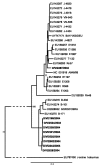Aichi virus shedding in high concentrations in patients with acute diarrhea
- PMID: 21801647
- PMCID: PMC3381558
- DOI: 10.3201/eid1708.101556
Aichi virus shedding in high concentrations in patients with acute diarrhea
Abstract
We assessed Aichi virus shedding in patients with gastroenteritis and negative test results for other viral and bacterial infections. High concentrations of up to 1.32 × 1012 RNA copies/g stool were found in 10 (2.0%) of 499 outpatients sampled in northern Germany, 2004. These data substantiate Aichi virus pathogenicity in humans.
Figures


References
Publication types
MeSH terms
Substances
Associated data
- Actions
- Actions
- Actions
- Actions
- Actions
- Actions
- Actions
- Actions
- Actions
LinkOut - more resources
Full Text Sources
Medical
